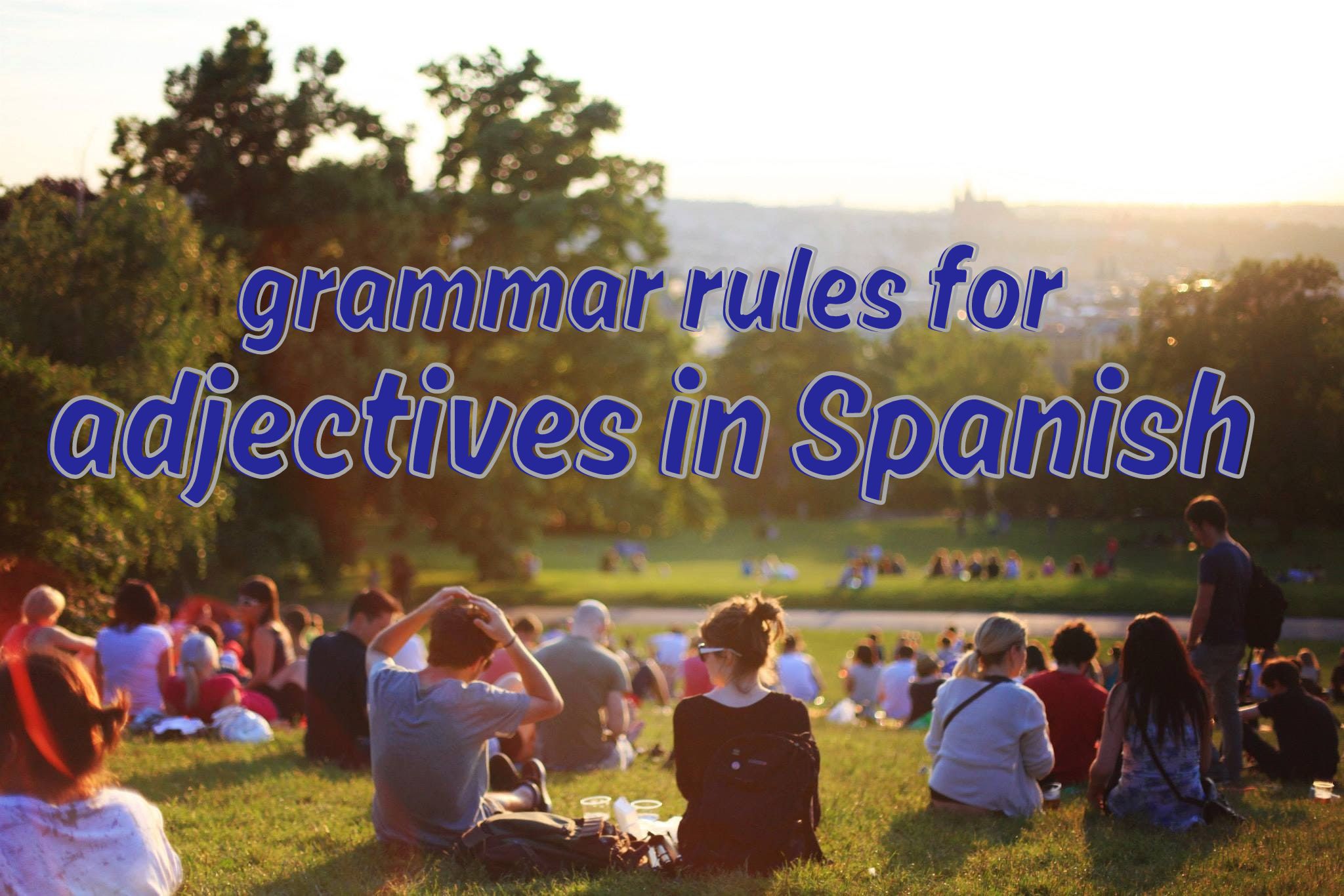Adjectives in Spanish: When and how to use them

Get our free email course, Shortcut to Conversational.
Have conversations faster, understand people when they speak fast, and other tested tips to learn faster.
More infoAre you ready to learn all the essentials about adjectives in Spanish? You’re in the right place!
We’ll start by introducing the two main rules you need to know for how to use Spanish adjectives: gender agreement and sentence placement. We’ll also touch on Spanish adjectives that have other rules you should know.
Since most people think of descriptive words when we mention adjectives, we’ll keep our focus on the descriptive adjectives in this post. Still, for completeness, we’ll also go through the other categories of adjectives to provide an overview of the full variety of adjectives in Spanish.
As we do in all our posts, we’ll provide plenty of examples so you can really see how to use Spanish adjectives in context. Wherever they can offer deeper explanations, we’ll also include useful links to our other detailed posts. This post is about grammar, so check out our complementary post with a list of over 100 Spanish adjectives to learn vocabulary.
We’ve totally updated these two posts on adjectives in Spanish to make them clearer and more in-depth for our learners. If you’d bookmarked either one and you’re returning to review a lesson, you should be pleasantly surprised at the improvements. Now let’s get started with today’s post on adjectives in Spanish!
What is an adjective?
Before we get into any rules, let’s just make sure we’re clear on this grammatical category: what is an adjective?
An adjective is a word that provides additional detail about a noun. An adjective is typically used to describe a quality of the noun, to indicate the noun’s quantity or extent, or to show that the noun is distinct from something else.
When we talk about how adjectives are used in a sentence, we say that the adjective modifies or describes the noun.
Adjectives are sometimes confused with adverbs, since both are used to provide additional information about other words. Adjectives always modify nouns. Adverbs, on the other hand, modify verbs, adjectives, or other adverbs. So if the descriptive word is referring to a noun, it’s an adjective.
Descriptive adjectives are the type we often think of, since they clearly describe nouns in such a way that we can envision. Think of such descriptive adjectives as tall, dark, and handsome. Other categories of adjectives aren’t as obvious, but still meet the criteria of modifying nouns, including demonstrative adjectives, possessive adjectives, indefinite adjectives, and relational adjectives.
We’ll keep this post’s focus on descriptive adjectives, but we’ll still introduce the other categories later on. Now let’s get into the fundamental rules for adjectives in Spanish!
Gender and number agreement
To get straight to the point here: all Spanish adjectives must agree in gender and number with the nouns they modify. This means that you need to choose a specific form of the adjective depending on whether it describes something that is masculine singular, feminine singular, masculine plural, or feminine plural. Now let’s break this rule down from the beginning.
Even if you’re a new Spanish learner, you probably know that all nouns in Spanish have a gender: either masculine or feminine. This is strictly a grammatical quality of the word itself, even if attaching a gender to some things may seem arbitrary to non-Spanish speakers. The easiest way to learn a noun’s gender is to look at its article, equivalent to a or the in Spanish: un and el are masculine, and una and la are feminine.
In Spanish, when we use an adjective to describe a noun, the grammatical explanation is that the adjective modifies the noun. Spanish adjectives have specific masculine and feminine forms to modify masculine and feminine nouns. Likewise, they have specific masculine plural forms and feminine plural forms to modify masculine and feminine plural nouns. In other words, most adjectives in Spanish have four distinct forms.
Let’s see how this works with the adjective meaning generous in Spanish, which is generoso. In its feminine form, we drop the -o at the end and replace it with an -a to get generosa. And in its plural forms, we add -s to either of its singular forms to get generosos and generosas.
- un hombre generoso – a generous man
- una mujer generosa – a generous woman
- unos hombres generosos – some generous men
- unas mujeres generosas – some generous women
As you can see, adjectives in Spanish that change form between masculine and feminine end in -o in their masculine form and end in -a in their feminine form.
The default form of adjectives in Spanish
If there’s no context, we use the masculine singular form of an adjective in Spanish. This is the default form we’ll see in vocab lists, for example, or in dictionary entries. To translate generous into Spanish on its own, for example, we’d forgo the other three forms and just use generoso.
To be more inclusive, adjectives are sometimes written with multiple endings: generoso/a or even generoso/a(s). Check out our post on gender-neutral Spanish for other ways to avoid always defaulting to the masculine adjectives in Spanish.
Invariable adjectives in Spanish
The first rule of gender agreement we just described has a set of exceptions, known as invariable adjectives. As their name suggests, these adjectives don’t change form between masculine and feminine. Nonetheless, they still need to take the -s in their plural form. Thus, invariable adjectives in Spanish still have two distinct forms: singular and plural.
As an example of an invariable adjective in Spanish, we’ll use inteligente. Whether modifying a masculine or feminine singular noun, the form remains inteligente. For either masculine or feminine plural nouns, we add an -s for it to become inteligentes.
- un hombre inteligente – an intelligent man
- una mujer inteligente – an intelligent woman
- unos hombres inteligentes – some intelligent men
- unas mujeres inteligentes – some intelligent women
The default forms of invariable adjectives in Spanish end in letters other than -o. They follow standard Spanish pluralization rules for their plural forms. Here are a couple of such examples where we don’t simply add -s:
- un hombre feliz, dos hombres felices – a happy man, two happy men
- una mujer joven, dos mujeres jóvenes – a young woman, two young women
In our companion post on Spanish adjectives, we include a list of the most common invariable verbs in Spanish.
Sentence placement for descriptive adjectives in Spanish
As you may have noticed so far with our examples, descriptive adjectives in Spanish are usually placed after the noun. There are a couple of other possibilities, so let’s see each one here.
After the noun
In Spanish, descriptive adjectives normally come after the noun. The English translation may take a different word order, but in Spanish this is the general rule.
- Carmen tiene un vestido negro. – Carmen has a black dress.
- El tipo alto es mi hermano rico. – The tall guy is my rich brother.
- La Casa Blanca se encuentra en Washington, DC. – The White House is located in Washington, DC.
After a linking verb
In sentences where we use a verb to link the noun to its descriptive adjective, the word order is the same as in English. Common linking verbs are ser (to be), estar, (to be), and parecer (to appear, to seem, to look like). Remember that the adjective still needs to respect the gender and number of the noun.
- Las niñas son felices. – The girls are happy.
- Los boletos estaban caritos. – The tickets were expensive.
- Estos zapatos parecen nuevos. – These shoes look brand new.
Before a noun
In some instances, a descriptive adjective in Spanish can be placed before a noun. This sentence structure is mainly used when highlighting a characteristic to give it particular emphasis.
- Los viejos zapatos todavía sirven. – The old shoes still fit.
- La vi en la playa con su joven marido. – I saw her on the beach with her young husband.
- La dura crisis económica está pasando factura. – The hard economic crisis is taking its toll.
Keep in mind that placing adjectives before a noun like this is not very common. This word order really takes on a literary or poetic tone, so to sound more natural you should just stick with the word order where the adjective comes after the noun. Some adjectives in Spanish, such as the colors, should never be placed before the noun.
A handful of adjectives in Spanish have a clipped form when they appear before a noun. The main ones you should learn are bueno/buen, malo/mal, and grande/gran (which we’ll see in the next section). This phenomenon of shortening words is called apocopation.
- Un buen libro. – Un libro bueno. – A good book.
- Un mal momento. – Un momento malo. – A bad moment.
Before or after a noun to change meaning
A few adjectives in Spanish have slightly different meanings when they’re placed before vs after a noun. We’ll introduce the most important examples of this phenomenon here. Just keep in mind that these are outliers: most adjectives in Spanish don’t change meaning!
Antiguo – Former, previous vs Old
- Mi antiguo trabajo. – My previous job.
- Mi casa antigua. – My old house.
Cierto – Certain vs True
- Una cierta edad. – A certain age.
- Una descripción cierta. – A true description.
Pobre – Poor (unfortunate) vs Poor (lacking money)
- ¡Pobre chica!, perdió a su papá. – Poor girl! She lost her dad.
- Él es un hombre pobre. – He is a poor man.
Verdadero – Real (used for emphasis) vs True
- Es un verdadero lío. – It is a real problem.
- Es una historia verdadera. – It is a true story.
Grande – Great, excellent vs Large, big
- Es una gran mujer. – She is a great woman.
- Es un edificio grande. – It is a large building.
You may have noticed that grande has a clipped form when placed before a noun: gran. We explain this phenomenon and more in our post on clipped words in Spanish.
Other categories of adjectives in Spanish
So far in this post we’ve kept our focus on descriptive adjectives. But what about the other categories of adjectives? Since this is a big overview lesson on adjectives in Spanish, we need to at least mention the other categories of words that are also considered adjectives.
Since each of these categories has its own set of rules, we have specific posts explaining the details for most of them. Click through the links to learn more about each of these categories of adjectives in Spanish.
Demonstrative adjectives
This, that, and these are the demonstrative adjectives in English. Ese, este, and aquel are the equivalents in Spanish, and they each have four unique forms to agree in gender and number of the nouns they modify.
- Este lugar es hermoso. – This place is beautiful.
- Me gusta ese perro. – I like that dog.
Possessive adjectives
We have two forms of possessive adjectives in Spanish, depending on whether they’re placed before or after the noun. We cover the former in our beginner post on possession and the latter in our video on possessive adjectives.
- ¿Cuál es tu apellido? – What is your last name?
- Esos libros son tuyos. – Those books are yours.
Comparative adjectives
Whereas in English you often change the form of your adjectives to make comparisons, we use a simpler construction in Spanish: más [adjective] que and menos [adjective] que. Your English equivalent is more [adjective] than and less [adjective] than. We cover this in our post on Spanish comparisons. We also have a post that introduces the similar tan + [adjective] + como construction, which is equivalent to as [adjective] as in English.
- Alejandro es más rápido que Arturo. – Alejandro is faster than Arturo.
- Ese edificio es más alto que los demás. – That building is higher than the others.
We’ll mention the only two exceptions to this rule here: bueno and malo, meaning good and bad. Just like in English, these two adjectives take unique forms as comparative adjectives: mejor and peor mean better and worse.
Superlative adjectives
These appear very similar to the comparative adjectives we just saw, but they describe the extremes. We just add an article before the comparison to say that it’s the most [adjective] or the least [adjective]. We explain this construction in our post on how to form superlatives in Spanish.
- Buenos Aires es la ciudad más bonita de Argentina. – Buenos Aires is the most beautiful city in Argentina.
- Tu disfraz es el menos gracioso de esta fiesta. – Your costume is the least funny at this party.
Indefinite adjectives
These adjectives introduce an intentional vagueness to the nouns they modify. Some details of their use are explained in our post on ningún vs ninguno. Most of these can also be considered quantitative adjectives.
- Ningún estudiante aprobó el examen. – No student passed the exam.
- Las mujeres pueden ser amigas de cualquier hombre. – Women can be friends with any man.
Quantitative adjectives
These adjectives can describe a quantity of a noun, whether specific or general. In this sense, the numbers in Spanish can even act as adjectives when they modify nouns.
- Tengo demasiadas mascotas. – I have too many pets.
- I like both types of wine, red and white. – Me gustan ambos tipos de vino, el rojo y el blanco.
Exclamatory adjectives
We just have a handful of exclamatory adjectives in Spanish, used before nouns to create an exclamation about it. See our posts on qué vs que, qué vs cuál, and how to use cuánto for more explanations and examples.
- ¡Qué buen día! – What a good day!
- ¡Cuánto frío! – How cold!
Relational adjectives
When we use a noun to modify another noun, it’s considered a relational adjective. Even though they’re used in similar contexts to descriptive adjectives, relational adjectives don’t change form to account for gender or number.
- Tu permiso laboral ha expirado y deberías renovarlo. – Your work permit has expired and you should renew it.
- Esta noche tendremos una cena familiar. – We are having a small family dinner tonight.
Conclusion: Adjectives in Spanish
Today we gave a broad overview of adjectives in Spanish, with an emphasis on descriptive adjectives.
The main rules to keep in mind with descriptive adjectives in Spanish are that they change form to respect the gender and number of the noun, and that they’re usually placed after the noun. That being said, we also saw that some descriptive adjectives are invariable between their masculine and feminine forms, and we saw contexts where the adjective can be placed before the noun.
For completeness, we finished our post with an introduction to the other categories of adjectives in Spanish. These each have their own sets of rules, so we provided links to our dedicated posts explaining the intricacies of each one.
Throughout the post, we provided plenty of examples of our Spanish adjectives in action. Now that you know how to use them, head over to our post with a list of the most common Spanish adjectives to learn over 100 important adjectives in Spanish!



